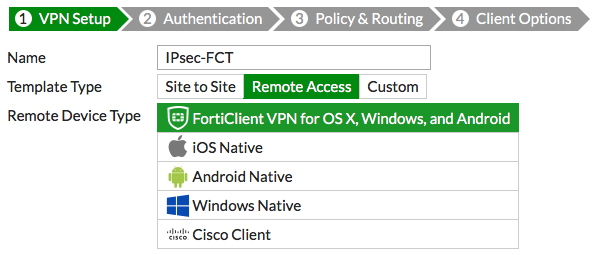


Create the SSL VPN user and add the user to a user group configured for SSL VPN use.

For Source IP Pools select SSLVPN_TUNNEL_ADDR1.Go to VPN > SSL-VPN Portals and select tunnel-access.Creating an SSL VPN IP pool and SSL VPN web portal Using SSL VPN and FortiClient SSL VPN software, you create a means to use the corporate FortiGate to browse the Internet safely. Essentially, the remote user will connect to the corporate FortiGate unit to surf the Internet. This example sets up an SSL VPN tunnel that provides remote users the ability to access the Internet while traveling, and ensures that they are not subject to malware and other dangers, by using the corporate firewall to filter all of their Internet traffic. Multiple user groups with different access permissionsĬlient device certificate authentication with multiple groups Secure Internet browsing create the PolicyĪfter creating the IPsec VPN tunnel, you need to create a policy which allows internal traffic to Azure and a policy for reverse.The examples in this chapter demonstrate the basic configurations needed for common connections to the SSL VPN tunnel and portals, applying the steps outlined in Basic configuration on page 17.

Select the Phase 1 configuration you created before and click to Create Phase 2 button:įor more security, you can also use AES256 for encryption. Go to VPN → IPSEC → Auto Key (IKE) and then click to Create Phase 1:įill in the form like this with the values get from Azure GateWay Setup:įor more security, you can also use AES256 for encryption.Īfter creating the VPN phase 1, create the phase 2. Please note, that i can’t give you support for FirmWare Versions below this. FortiGate configurationįor this configuration, i used a FotiGate 60C with Firmware Version v5.0,build0147 GA 1. To see the created preshared key, click to the Manage Key button at the botton. When the Gateway is created, you will see this Screen, on which you will see the ip address which is needed for the FortiGate configuration: during this time you will see this Screen: Now, the Gateway will be created, this will Need around 15-20 minutes. on the bottom click to the Create Gateway button and select Dynamic Routing. Open your virtual Network and go to the Dashboard tab. you can use it now for your virtual machines and other resources inside Azure, but you can’t connect to it from outside Azure before creating the gateway. After a few minutes your virtual network is created. please note, that you shouldn’t use the first available subnet, cause it will be used at the next step:īefore clicking to Finish button, click to add gateway subnet: Now define the address range of your virtual network and its subnets. Set the Configure site-to-site VPN checkbox, but no other options:Ĭonfigure your local network with your current settings and tell the public ip address of your firewall: Azure preparation virtual Network creationįirst we need to create a new virtual network:ĭefine the Name for the virtual network and optionally an affinity group: The differences between dynamic and static routing gateways are described here. After trying the old option Static Routing Gateway, I tried the new one and was successfully.
#FORTINET VPN SETUP 5.0 WINDOWS#
So this week, I started a new try with this problem and after a few test’s I was successfully.įirst I detected, that there is a new Option in Windows Azure, I never saw before: Dynamic Routing GateWay. I tried a lot of configurations, but nothings seams to run with Azure and my Fortigate firewall. But a FortiGate device is what i have and only to run some test’s I don’t want to buy some of this expensive supported firewalls. I know, it is an unsupported configuration to create a site-to-site VPN to Microsoft Azure with a FortiGate firewall.


 0 kommentar(er)
0 kommentar(er)
